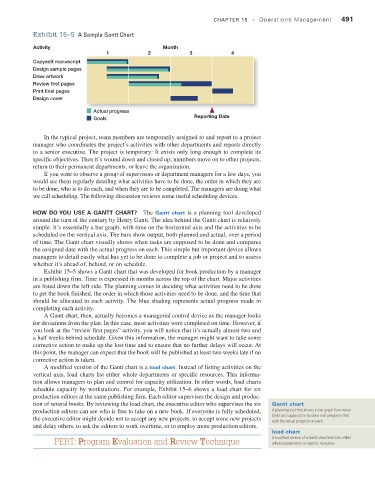Page 492 - Fundamentals of Management Myths Debunked (2017)_Flat
P. 492
Exhibit 15–5 A Sample Gantt Chart CHAPTER 15 • Operations Management 491
Activity Month
1 2 3 4
Copyedit manuscript
Design sample pages
Draw artwork
Review first pages
Print final pages
Design cover
Actual progress
Goals Reporting Date
In the typical project, team members are temporarily assigned to and report to a project
manager who coordinates the project’s activities with other departments and reports directly
to a senior executive. The project is temporary: It exists only long enough to complete its
specific objectives. Then it’s wound down and closed up; members move on to other projects,
return to their permanent departments, or leave the organization.
If you were to observe a group of supervisors or department managers for a few days, you
would see them regularly detailing what activities have to be done, the order in which they are
to be done, who is to do each, and when they are to be completed. The managers are doing what
we call scheduling. The following discussion reviews some useful scheduling devices.
how do you use a gantt Chart? The Gantt chart is a planning tool developed
around the turn of the century by Henry Gantt. The idea behind the Gantt chart is relatively
simple. It’s essentially a bar graph, with time on the horizontal axis and the activities to be
scheduled on the vertical axis. The bars show output, both planned and actual, over a period
of time. The Gantt chart visually shows when tasks are supposed to be done and compares
the assigned date with the actual progress on each. This simple but important device allows
managers to detail easily what has yet to be done to complete a job or project and to assess
whether it’s ahead of, behind, or on schedule.
Exhibit 15–5 shows a Gantt chart that was developed for book production by a manager
in a publishing firm. Time is expressed in months across the top of the chart. Major activities
are listed down the left side. The planning comes in deciding what activities need to be done
to get the book finished, the order in which those activities need to be done, and the time that
should be allocated to each activity. The blue shading represents actual progress made in
completing each activity.
A Gantt chart, then, actually becomes a managerial control device as the manager looks
for deviations from the plan. In this case, most activities were completed on time. However, if
you look at the “review first pages” activity, you will notice that it’s actually almost two and
a half weeks behind schedule. Given this information, the manager might want to take some
corrective action to make up the lost time and to ensure that no further delays will occur. At
this point, the manager can expect that the book will be published at least two weeks late if no
corrective action is taken.
A modified version of the Gantt chart is a load chart. Instead of listing activities on the
vertical axis, load charts list either whole departments or specific resources. This informa-
tion allows managers to plan and control for capacity utilization. In other words, load charts
schedule capacity by workstations. For example, Exhibit 15–6 shows a load chart for six
production editors at the same publishing firm. Each editor supervises the design and produc-
tion of several books. By reviewing the load chart, the executive editor who supervises the six Gantt chart
production editors can see who is free to take on a new book. If everyone is fully scheduled, A planning tool that shows in bar graph form when
the executive editor might decide not to accept any new projects, to accept some new projects tasks are supposed to be done and compares that
with the actual progress on each
and delay others, to ask the editors to work overtime, or to employ more production editors.
load chart
PERT: Program Evaluation and Review Technique A modified version of a Gantt chart that lists either
whole departments or specific resources

